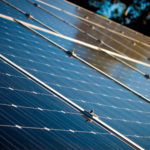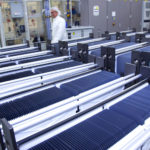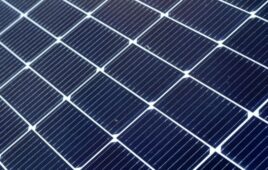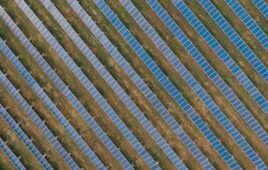The Dept. of Commerce has requested additional information from a group of anonymous American solar manufacturers in reference to a petition to review Chinese solar panel companies allegedly circumventing antidumping and countervailing (AD/CV) duties by manufacturing portions of their product in three Southeast Asian countries.
“We have examined your submissions and have determined that we require additional information to address certain threshold issues before we can consider the merits of your requests for anticircumvention rulings,” stated Abdelali Elouaradia, office director for the Dept. of Commerce, in a Sept. 29 letter to the law firm Wiley Rein LLP, which is representing petitioners American Solar Manufacturers Against Chinese Circumvention (A-SMACC).
The group has until Oct. 6, 2021 Oct. 13, 2021, to provide Commerce with further proof of tariff circumvention by Chinese companies working in Malaysia, Thailand and Vietnam, and then the department will initiate a 45-day review.
Solar advocacy group SEIA, which had requested Commerce to dismiss the petition outright, said it was disappointed with this decision to continue the review.
“However, the detail and nature of the questions Commerce asked the anonymous petitioners clearly indicates that the petitioners have produced a filing largely devoid of the information the department needs to assess whether to initiate this case,” said Abigail Ross Hopper, president and CEO of SEIA. “We believe that when and if the petitioners amend their original submission, it will become abundantly clear that they have no case for circumvention.”
In August A-SMACC filed a petition with the Dept. of Commerce asking for an investigation into Chinese silicon solar panel manufacturing companies working in Malaysia, Thailand and Vietnam as a way to avoid AD/CV duties. Various forms of these duties have been in place against Chinese solar manufacturers since 2012. Any silicon solar imports from China come with an extra tax from the Dept. of Commerce. Some Chinese companies, in a possible attempt to avoid paying the tax, have moved portions of their manufacturing capacity to other Southeast Asian countries, according to the petition.
A-SMACC asked Commerce for a deeper look into specific Chinese companies working in the three mentioned countries:
- Malaysia: JinkoSolar, LONGi (and affiliates), JA Solar
- Thailand: Canadian Solar, Trina Solar, Talesun Solar, Astroenergy
- Vietnam: Trina Solar, Canadian Solar, Sunergy, Boviet Solar, GCL, LONGi (and affiliates), JinkoSolar
The petitioners want additional tariffs ranging from 50 to 250% on imports from the above companies. Commerce has asked for additional information to determine if the petition has merit.
Among the requests from Commerce is identification of the anonymous members of A-SMACC and their related operations to the solar industry. Commerce is also asking for the reasons why the anonymous members feel they will receive retaliation from the Chinese companies if they are named.
Additionally, Commerce wants to know where A-SMACC members are importing the solar cells used in their American panels, and whether they have any operations in Malaysia, Thailand or Vietnam.
This petition has already sent ripples through the U.S. solar industry. Around 80% of U.S. crystalline silicon solar module imports in the first half of 2021 came from Malaysia, Thailand and Vietnam, with 59% of the country’s total supply of modules coming from those three countries. SEIA and several solar installers stated in a press conference this week that solar module supply from those countries has already been halted, and thousands of jobs are at risk.
With no domestic silicon solar cell manufacturers, and domestic module manufacturing capacity at less than 8 GW, the United States is dependent on solar module imports to meet demand. The country is expected to install 30 GW of solar in 2022 and 32 GW in 2023. Without supply from Malaysia, Thailand and Vietnam, SEIA has predicted installs to fall to less than 26 GW in 2022 and 18 GW in 2023 — or a loss of 18 GW over the next two years.
One reason behind A-SMACC’s petition is that further tariffs would boost domestic manufacturing, but with the time and financial investments needed to start domestic cell production and grow module assembly capacity, installation numbers will suffer. And any drop in expected solar installations would put the country further behind in meeting the Biden Administration’s clean energy goals.
“Growing the U.S. solar supply chain is of critical importance,” Hopper said earlier this week. “Long-term policy that drives solar demand and incentivizes a healthy manufacturing sector can drive a strong U.S. manufacturing renaissance. However, needless and harmful tariffs are not the solution.”
With this latest Commerce request back to the petitioners, the 45-day initiation deadline resets. A-SMACC has until Oct. 6 Oct. 13 to provide more information, and then Commerce could make its final decision on Nov. 22 Nov. 29.
Oct. 6 update: Commerce has granted another extension. A-SMACC now has until Oct. 13 to provide required information.










““We have examined your submissions and have determined that we require additional information to address certain threshold issues before we can consider the merits of your requests for anticircumvention rulings,” stated Abdelali Elouaradia, office director for the Dept. of Commerce, in a Sept. 29 letter to the law firm Wiley Rein LLP, which is representing petitioners American Solar Manufacturers Against Chinese Circumvention (A-SMACC).””
Is this a legitimate gripe or a “dark money” move to manipulate the industry as a whole to shore up and enhance assets held by these same companies right now?
“Among the requests from Commerce is identification of the anonymous members of A-SMACC and their related operations to the solar industry. Commerce is also asking for the reasons why the anonymous members feel they will receive retaliation from the Chinese companies if they are named.”
I believe one issue was brought up by the article on the start up company, this company has problems finding small scale American supply chains to meet their manufacturing needs. These companies may be depending at some level on the Chinese solar PV supply chain to keep feeding their businesses, unfortunately if this is true, they’ve just shot themselves in their big floppy clown shoes over this move.